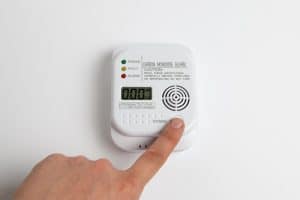New Year, New Batteries: Home Safety Tips to Prevent Fires and Carbon Monoxide Poisoning
 As we approach the new year, it’s a good time to make sure the batteries in your smoke and carbon monoxide detectors are working. These little devices are like your home’s superheroes, alerting you early if there’s a fire or dangerous carbon monoxide in the air. Fires can start without much warning (like when a space heater sits too close to something flammable) and carbon monoxide is sneaky – you can’t see or smell it (did you leave the oven on? Is that gas fireplace leaking?). So, taking a moment to check and replace the batteries can make your home a safer place for you and your family in the coming year.
As we approach the new year, it’s a good time to make sure the batteries in your smoke and carbon monoxide detectors are working. These little devices are like your home’s superheroes, alerting you early if there’s a fire or dangerous carbon monoxide in the air. Fires can start without much warning (like when a space heater sits too close to something flammable) and carbon monoxide is sneaky – you can’t see or smell it (did you leave the oven on? Is that gas fireplace leaking?). So, taking a moment to check and replace the batteries can make your home a safer place for you and your family in the coming year.
The troubling statistics of house fires
According to Bankrate, House fires pose a significant and prevalent risk across the United States, with more than 26 percent of reported fires occurring in residential homes between 2016 and 2020, according to the National Fire Protection Association (NFPA). In 2021 alone, U.S. fire departments responded to a fire every 23 seconds on average, translating to a home fire every 93 seconds. Shockingly, one fatal house fire occurred approximately every two hours and 18 minutes, contributing to the concerning fact that the rate of home fire fatalities has not improved over the past few decades.
Despite accounting for only a quarter of reported fires nationwide, home fires resulted in substantial consequences, causing an estimated $3.6 billion in direct property damage in 2021. Disturbingly, almost three out of every five fatal home fire victims were aged 55 or over, emphasizing the vulnerability of older individuals. The kitchen emerged as a focal point for home fire incidents, comprising about 44 percent of cases, while most house fires occurred during the early evening hours of 5 p.m. to 8 p.m. Although only 17 percent of house fires were reported between 11 p.m. and 7 a.m., they led to nearly half of all home fire deaths in the same year. These statistics underscore the urgent need for increased awareness, preventive measures, and safety practices to mitigate the devastating impact of house fires across the nation.
The dangers of carbon monoxide
The Centers for Disease Control and Prevention states that “every year, at least 420 people die in the U.S. from accidental CO [Carbon Monoxide] poisoning. More than 100,000 people in the U.S. visit the emergency department each year due to accidental CO poisoning.” CO is present in the fumes emitted by various sources, including furnaces, kerosene heaters, vehicles left running in enclosed garages, stoves, lanterns, gas ranges, portable generators, and the combustion of charcoal and wood. When released, CO can accumulate in enclosed or partially enclosed spaces, posing a serious threat. Inhaling CO can lead to poisoning, and both people and animals within these spaces are at risk of severe harm or even death due to CO inhalation.
Space heaters can be deadly
During these colder months, it is important to highlight the risks that space heaters pose when it comes to housefires. The Consumer Product Safety Commission (CPSC) knows exactly how often these room warming devices can lead to tragedy. “CPSC estimates that portable heaters, including electric space heaters, were involved in an average of 1,700 fires per year, resulting in an average of 70 deaths and 160 injuries annually from 2017 to 2019.”
If space heaters are too close to things like curtains, furniture, or beds, they can start a fire. It is important to make sure there’s at least three feet of space between the heater and these things. When you’re plugging in an electric heater, go straight to the wall – don’t use extension cords or power strips. Using those can overload things and lead to a fire. And here’s a big one: don’t leave the heater on when you’re sleeping. If you have a heater that runs on fuel, like kerosene, never try to refuel it while it’s still on. Turn it off, let it cool down, and then add more fuel.
Not only can space heaters cause fires, but they can be a source of CO poisoning as well. While electric space heaters do not produce CO, gas space heaters do. These types of heaters run on fuel and indoor air for heating but release the gasses they produce directly into the room instead of outside. If a space heater is not correctly installed or malfunctions, it can release carbon monoxide and other harmful fumes into the room, depleting the oxygen available. This highlights the importance of proper installation and maintenance for the safety of those using space heaters indoors. It also shows how important ventilation is to a space if the heater does malfunction, as the room will take longer to fill up with the potentially fatal gas.
Check your smoke and CO detectors in the new year
Even if you are taking all precautions, perhaps the most important precaution you can take is having both smoke and carbon monoxide detectors installed, changing their batteries regularly.
To enhance home safety, the National Fire Protection Association (NFPA) recommends strategic placement of smoke detectors and carbon monoxide alarms. For smoke detectors, install them on every level, inside each bedroom, and outside sleeping areas. Place them high on walls or centrally on ceilings, at least 10 feet away from cooking appliances. If on the wall, position them within 12 inches from the ceiling for optimal effectiveness.
Carbon monoxide alarms should mirror the placement of smoke detectors, extending to attached garages and locations specified by the manufacturer. However, avoid installing carbon monoxide alarms too close to fuel-burning appliances, in humid areas, in direct sunlight, or where there’s excessive air circulation. Regular testing and battery changes every six months are crucial to ensure these detectors provide continuous protection for your home.
Unfortunately, there are instances where a smoke or CO detector turns out to be defective, and when this happens, you and your loved ones can end up severely injured. That is why it is always a good idea to check to see if your brands and models of detectors have been issued recalls. Checking CPSC is a good place to start, as they will have a list of all recalled products.
If you or a loved one have been injured or worse due to a malfunctioning, defective, or recalled smoke or CO detector, you deserve justice. At Gainsberg Injury and Accident Lawyers, we ensure that you receive rightful compensation for your injuries, pain, and suffering, as well as any property loss that may have occurred due to a house fire. To schedule a free consultation, call us in Chicago, or use our contact form.

Attorney Neal Gainsberg has spent the last 20+ years fighting to protect the rights of the injured in Chicago and throughout Illinois. For dedicated legal help with a personal injury, car accident, or wrongful death matter, contact Gainsberg Injury and Accident Lawyers in Chicago for a free consultation.
